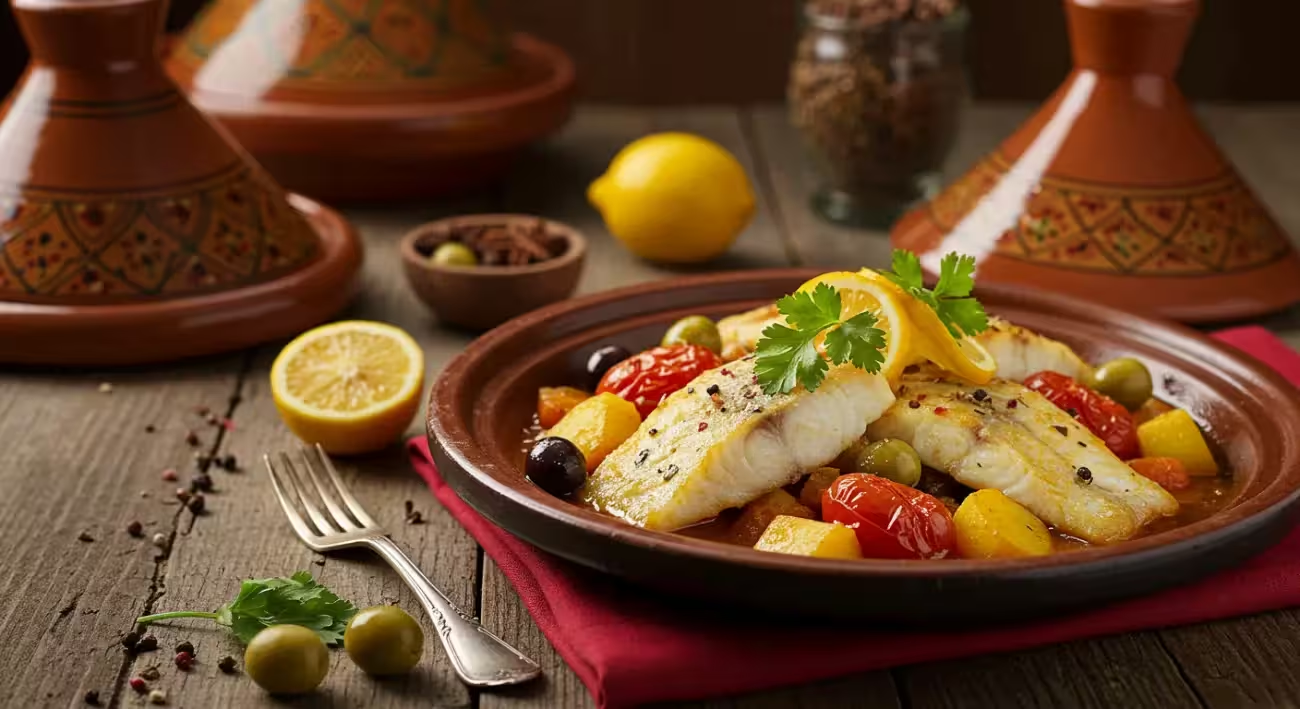Table of Contents
🍽️ Discover the Perfect Fusion: Pollock Meets Moroccan Flavor
Hey there, foodies! Are you ready to embark on a culinary adventure that combines the vibrant flavors of Morocco with the tender, mild taste of pollock fish? 🐟✨
If you’ve been looking to jazz up your dinner menu or impress your loved ones with something new and exciting, you’re in the right place.
Pollock fish might not be the first ingredient that comes to mind when you think of Moroccan cuisine, but trust me, it’s a match made in food heaven.In fact, pollock is an excellent source of lean protein and heart-healthy omega-3s, making it a smart choice for nutritious family meals.
In this article, we’ll dive into savory Moroccan pollock fish recipes that balance nutrition and taste. For another example of how Moroccan cuisine elevates fish dishes, visit our Chermoula Fish Tagine recipe — it’s a classic worth trying!
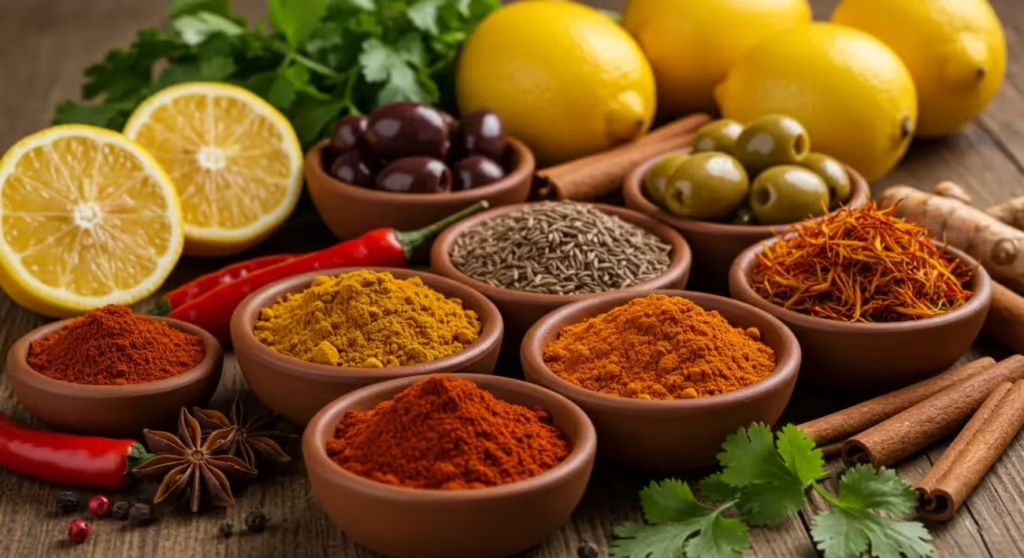
🧄 What Makes Moroccan Pollock Fish Recipes Unique?
Okay, what’s the big deal about Moroccan cuisine and pollock fish? Well, let’s break it down. Imagine taking a trip to the bustling markets of Marrakech, where the air is filled with the tantalizing aroma of exotic spices, fresh herbs, and sizzling street food. Now, pair that magic with the tender, flaky goodness of pollock, and you’ve got a dish that’s as vibrant as Morocco itself.
🌶️ Flavorful Spices and Ingredients
First things first—let’s talk spices. Moroccan dishes are famous for their bold and aromatic spice blends; these are the real MVPs for transforming pollock into something extraordinary.
Here’s the star lineup of Moroccan spices you’ll find in most recipes:
- Saffron: The queen of spices, lending a delicate, floral aroma.
- Cumin: Earthy and warm, giving your dish that signature depth.
- Paprika: For a subtle smoky kick.
- Coriander: Adds a bright, citrusy note.
- Turmeric: Not just for color—it brings a subtle bitterness that balances the flavors.
Then there are the must-have Moroccan staples:
- Preserved lemons: Think of these as lemons on steroids—super tangy and salty.
- Olives: A handful of these bad boys adds a burst of brininess.
- Fresh herbs: Parsley and cilantro are non-negotiable.
With these ingredients, you’re not just seasoning your food but crafting an edible masterpiece. The spices coat the fish and seep into every flake, making each bite an explosion of flavor. 🎇
“Good food is the foundation of genuine happiness.” – Auguste Escoffier.
And nothing brings more happiness than a dish loaded with Moroccan spices.
For another spice-rich favorite, don’t miss our Epic Moroccan Bastilla — a showstopper packed with flavor and tradition.
🥗 Health Benefits of Pollock and Moroccan Cuisine
Let’s talk health for a second. Pollock isn’t just delicious; it’s also a nutritional powerhouse. It’s packed with lean protein, low in calories, and omega-3 fatty acids, like little superheroes for your heart and brain.
According to Harvard’s School of Public Health, omega-3s play a vital role in reducing inflammation and supporting cardiovascular health.
Combine that with the nutrient-rich ingredients in Moroccan cooking—like antioxidant-packed spices and fresh vegetables—and you’ve got a dish that’s as good for your body as it is for your taste buds.
Feeling guilty about indulging? Forget about it! Moroccan pollock recipes strike the perfect balance between healthy and hearty. Whether you’re watching your waistline or want to eat cleaner, this is the way.
🍲 Tagine Cooking Tradition
Now, let’s talk about the star of Moroccan cooking: the tagine. If you’ve never heard of it, a tagine is a cone-shaped clay pot that’s a magician in the kitchen. It locks in moisture and flavors, creating tender, juicy, and out-of-this-world-tasty dishes. Think of it as slow cooking but with way more personality.
If you don’t have a tagine, don’t sweat it! A good old Dutch oven or a regular pot with a tight-fitting lid will do the trick. The secret is to simmer the fish, letting all those spices and ingredients mingle like best friends at a reunion. The result? A meal so delightful, it deserves to be shared far and wide.
🐟 Why Pollock Works So Well in Moroccan Recipes
Now, you might be wondering, “Why pollock?” Well, here’s the thing: pollock is like the blank canvas of the fish world. Its mild, sweet flavor makes it the perfect base for bold Moroccan spices. Plus, it’s affordable, widely available, and easy to cook. Whether you’re a kitchen newbie or a seasoned pro, pollock has your back.
And let’s not forget the texture. Pollock is firm yet flaky, which means it holds up beautifully in tagines, stews, and even grilled recipes. No falling apart or turning mushy here!
🧯 Common Problems and Solutions
Cooking fish can be tricky, right? But don’t worry—I’ve got your back. Here are a few common issues people face with Moroccan pollock recipes and how to fix them:
- Problem: The fish tastes bland.
Solution: Don’t skimp on the marinade! Marinate the pollock in olive oil, lemon juice, garlic, and spices for at least 30 minutes before cooking. - Problem: The fish falls apart while cooking.
Solution: Handle the fillets gently and use a spatula to turn them. If you’re using a tagine, you don’t need to flip the fish—let it cook undisturbed. - Problem: The spices are too overpowering.
Solution: Balance is key. If your dish is too spicy, add a dollop of plain yogurt or a splash of lemon juice to tone it down.
“Cooking is like love: It should be entered into with abandon or not at all.” – Harriet Van Horne.
So throw yourself into these recipes passionately—you won’t regret it! 💕
🐟 Easy Moroccan Pollock Fish Recipes
Are you ready to bring a bit of Morocco to your kitchen? Let’s dive into making a Moroccan Pollock Fish Tagine—a full dish bursti dish flavor. Don’t worry if you’re new to cooking with a tagine or even pollock; I’ll guide you through every step. By the end of this, you’ll feel like a tagine master. 🧑🍳✨
If you’re new to cooking with a tagine, you might also enjoy our Fish Tagine with Artichokes and Peas — another easy and flavorful dish from the Moroccan sea table.
🛒 Ingredients You’ll Need
Before you roll up your sleeves, let’s gather the goods. The beauty of this recipe is that it uses simple ingredients that, when combined, create magic. Here’s what you’ll need:
For the Fish:
- 4 pollock fillets (fresh or frozen, thawed)
- 2 tbsp olive oil
- 2 tbsp fresh lemon juice
- 3 garlic cloves, minced
- 1 tsp ground cumin
- 1 tsp paprika
- 1/2 tsp turmeric
- Salt and pepper, to taste
For the Tagine Base:
- 2 tbsp olive oil
- 1 onion, thinly sliced
- 2 tomatoes, chopped
- 1 cup potatoes, sliced into rounds
- 1/2 cup green or black olives
- 2 preserved lemons, sliced thin
- 1/2 cup fish or vegetable stock
- A pinch of saffron threads, soaked in 2 tbsp warm water
- Fresh parsley and cilantro, chopped (for garnish)
Pro Tip: Don’t have preserved lemons? You can substitute fresh lemon slices with a pinch of salt, though preserved lemons add a unique tangy flavor you won’t miss!
Curious about preserved lemons and how to make your own? This guide from The Spruce Eats walks you through it.
🥘 Step-by-Step Cooking Instructions
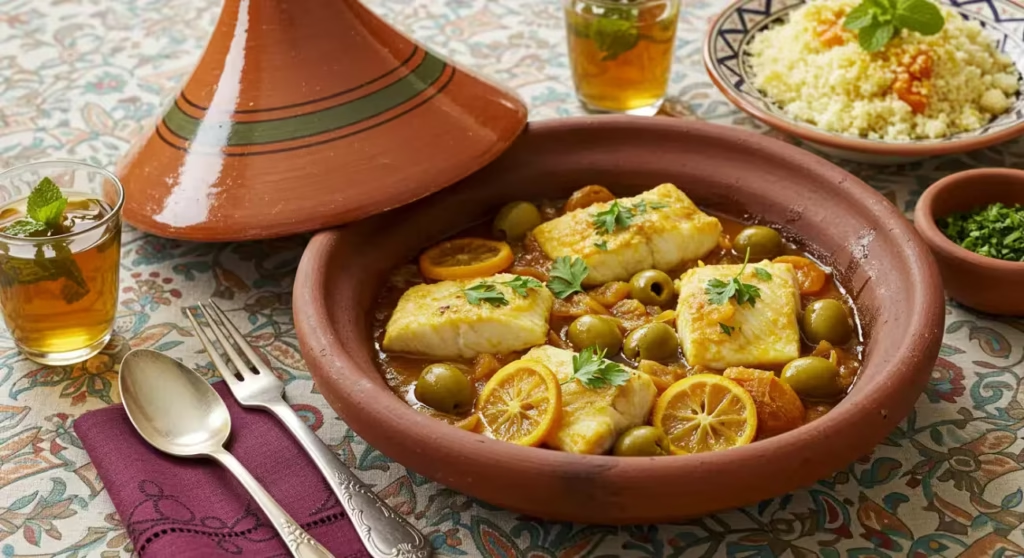
Ready? Let’s make some magic happen!
Step 1: Marinate the Fish
- Mix olive oil, lemon juice, garlic, cumin, paprika, turmeric, salt, and pepper in a bowl.
- Coat the pollock fillets in the marinade and let them rest for 30 minutes. This is where the flavors start to work their magic.
Why marinate? It’s like giving the fish a pre-party. The spices seep in, making every bite flavorful and delicious.
Step 2: Prepare the Tagine Base
- Heat olive oil in your tagine (or a Dutch oven) over medium heat.
- Add the sliced onion and sauté until it’s soft and fragrant.
- Layer the sliced potatoes on top of the onions and chopped tomatoes.
- Scatter the olives and preserved lemon slices over the top.
Step 3: Arrange the Fish
- Lay the marinated pollock fillets gently over the vegetable mixture.
- Pour the saffron water and fish/vegetable stock evenly over everything.
Why saffron water? It’s like liquid gold, adding a luxurious aroma and color to your dish.
Step 4: Cook the Tagine
- Cover the tagine with its lid and reduce the heat to low.
- Let it simmer gently for 25-30 minutes, checking occasionally to ensure nothing sticks.
- The pollock will cook through, and the vegetables will become tender, soaking up all the flavors.
Step 5: Garnish and Serve
- Once done, sprinkle fresh parsley and cilantro over the top.
- Serve the tagine straight from the pot with a side of fluffy couscous or warm crusty bread to soak up all that incredible sauce. 🍞✨
❗ Common Problems and Solutions
Cooking can be challenging, but don’t worry—I’ve got solutions for every bump in the road.
Problem: The Fish Sticks to the Pot
- Solution: Make sure you’re using enough olive oil at the base. To act as a buffer, you can also line the bottom with a few extra slices of tomato or potato.
Problem: The Dish is Too Watery
- Solution: Reduce the amount of stock or cook uncovered for the last 5 minutes to let the liquid evaporate slightly.
Problem: The Fish is Overcooked
- Solution: Pollock cooks quickly, so keep an eye on it. The fillets are perfectly cooked when they gently break apart with a fork.
“Cooking is about patience. A watchful eye and a little love go a long way!”
✅ Why This Recipe Works
This recipe is like a symphony of flavors—every ingredient plays its part. The saffron and preserved lemons bring brightness, the olives add a salty punch, and the spices tie it together in a warm, comforting hug. And the pollock? It soaks up all these flavors like a sponge, giving you a dish as satisfying as beautiful.
🇲🇦 A Taste of Morocco at Your Table
There you have it—a dish as close as you’ll get to Morocco without hopping on a plane. 🛫
From the rich, earthy spices to the melt-in-your-mouth pollock, this recipe is a guaranteed crowd-pleaser. And the best part? It’s surprisingly easy to make, even if you’ve never tried Moroccan cooking.
🎨 Variations of Moroccan Pollock Fish Recipes
If there’s one thing I love about Moroccan cuisine, it’s how versatile it is. You can take the same core ingredients and tweak the cooking method or seasoning to create a completely different dish. So, if you’re feeling adventurous (and I know you are), here are a few creative twists on Moroccan pollock recipes you can try. 🎨✨
Curious about other unique Moroccan fish creations? Don’t miss our Ultimate Moroccan Fish Balls Tagine — a comforting favorite with a fun twist!
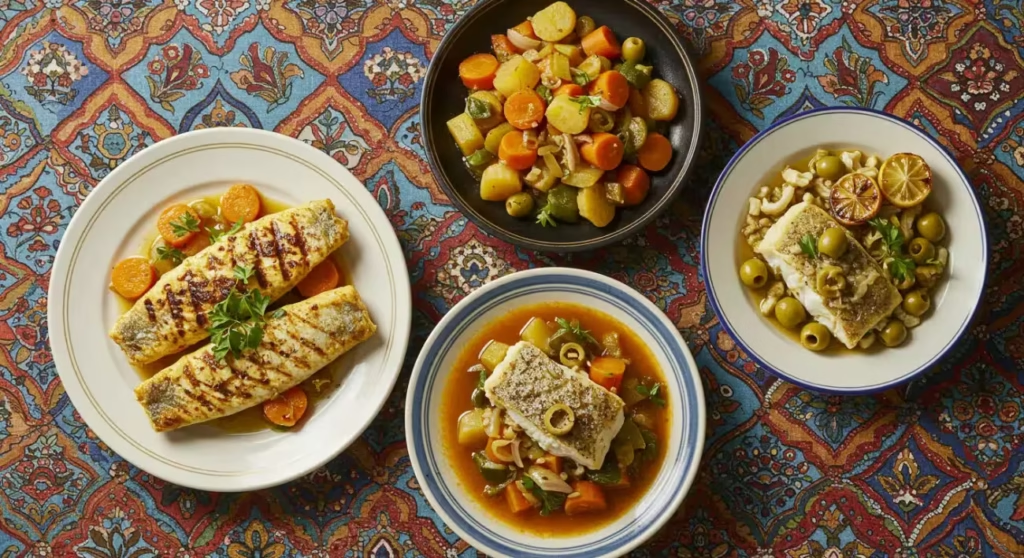
🔥 Grilled Pollock with Moroccan Spices
Grilling pollock is a fantastic option for those who love a smoky, charred flavor. It’s quick, healthy, and perfect for warm-weather cookouts or when you just want something light.
How to Make It:
- Prepare a spice rub using cumin, paprika, coriander, garlic powder, and a touch of cayenne for heat.
- Rub the spice mix generously over the pollock fillets and drizzle with olive oil.
- Heat your grill to medium-high and lightly oil the grates to keep food from sticking.
- Grill the fillets for 3-4 minutes per side or until the fish flakes easily with a fork.
- Serve with a side of couscous salad and a dollop of harissa for an extra kick. 🌶️
Why it works: The smoky grill enhances the spices, giving the pollock a bold and irresistible flavor.
Want to make your own harissa at home? This guide from The Mediterranean Dish shows you how to craft it authentically.
🍲 Moroccan Pollock Fish Stew
This hearty stew is comfort food at its finest. It’s loaded with fresh vegetables, fragrant spices, and tender chunks of pollock, all simmered in a rich tomato-based broth.
How to Make It:
- Cook onions, garlic, and bell peppers in olive oil until tender.
- Add diced tomatoes, fish stock, saffron water, and spices (cumin, turmeric, and paprika).
- Simmer for 10 minutes, then gently add pollock chunks to the stew.
- Cook for 10-15 minutes until the fish is tender and infused with the broth.
- Serve with crusty bread or over a bed of rice. 🍲
Why it works: The stew is rich and comforting, perfect for cold days when you need something warm and satisfying.
🧂 Baked Pollock with Preserved Lemon and Olives
If you’re looking for a simple recipe, this one is for you. Baking pollock allows you to set and forget it, making it ideal for busy weeknights.
How to Make It:
- Preheat your oven to 375°F (190°C).
- Arrange pollock fillets in a baking dish and top with slices of preserved lemon, olives, and cherry tomatoes.
- Drizzle with olive oil and sprinkle with cumin, paprika, and a pinch of salt.
- Bake for 15-20 minutes, or until the fish turns opaque and flakes effortlessly with a fork.
- Garnish with fresh parsley and serve with steamed vegetables or couscous.
Why it works: The preserved lemon and olives create a bright, tangy, salty flavor profile that beautifully complements the mild pollock.
📝 Tips for Perfect Moroccan Pollock Fish Recipes
Whether you’re a beginner or a seasoned chef, these tips will help you take your Moroccan pollock dishes to the next level.
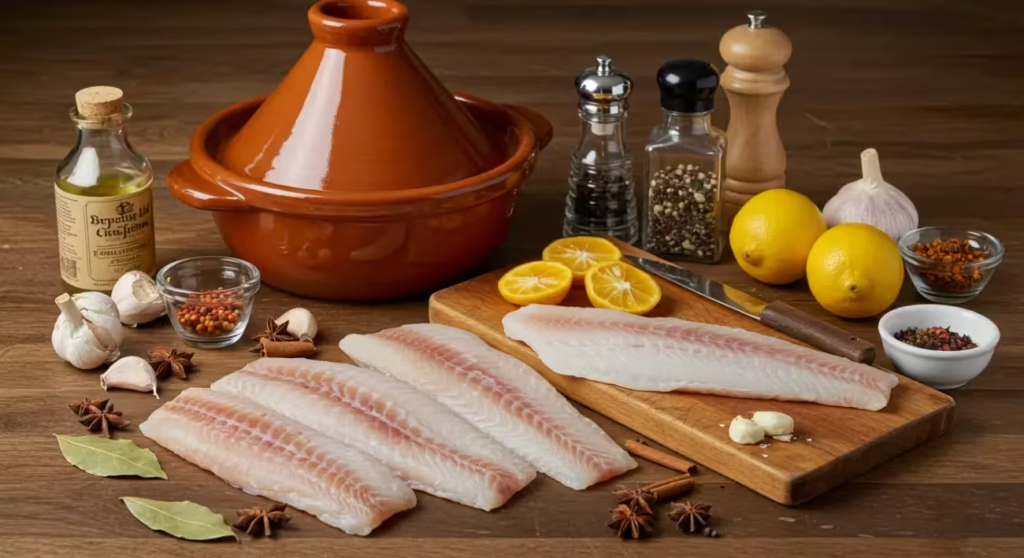
🐟 How to Choose Fresh Pollock Fish
- Look for firm flesh: Fresh pollock should feel firm to the touch, not mushy.
- Check the smell: It should have a clean, ocean-like scent—anything overly “fishy” is a red flag.
- Inspect the color: Fresh pollock fillets are typically white with a slight sheen.
🌿 Enhancing Flavors with Moroccan Spices
- Toast your spices: Heating spices in a dry pan for a few seconds releases their essential oils and enhances their aroma.
- Layer flavors: Add spices at different stages of cooking to create depth and complexity.
- Adjust to taste: Moroccan cooking is all about balance, so don’t be afraid to tweak spice levels to suit your palate.
🍽️ Pairing Moroccan Pollock Fish Recipes
- Traditional sides: Couscous, flatbread, or roasted vegetables are perfect complements.
- Beverage pairings: Try Moroccan mint tea for a refreshing contrast, or if you’re indulging, pair your dish with crisp white wine.
Pro Tip: Drizzle a little harissa or yogurt-based sauce over your dish for an extra layer of flavor!
🛠️ Troubleshooting Common Problems with Pollock Fish Recipes
Even the best cooks hit a snag now and then. Here’s a guide to solving some of the most frequent challenges.
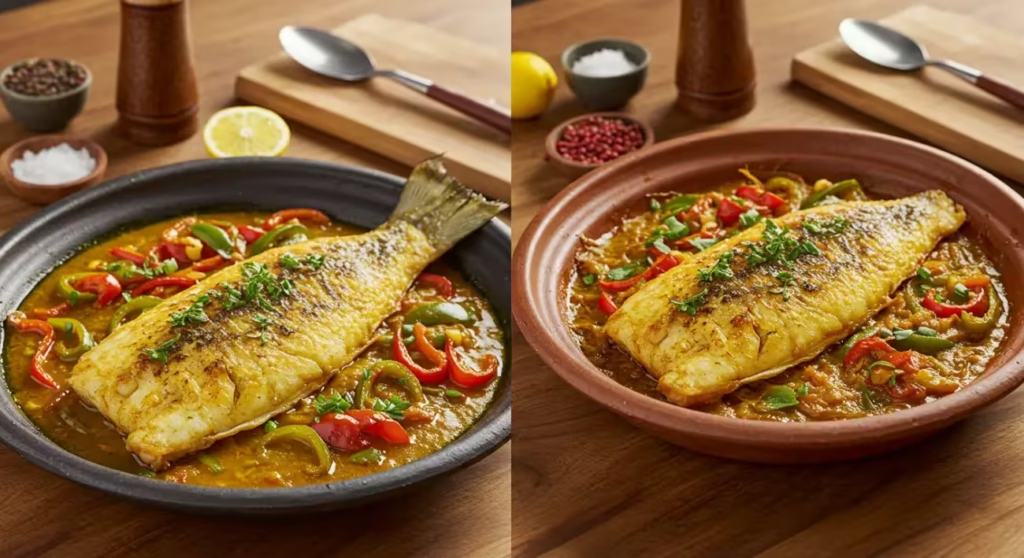
❌ Dry or Overcooked Pollock
- Problem: Your fish turns out dry and chewy.
- Solution: Reduce cooking time and check the fish frequently. Remember, pollock cooks quickly—once it flakes easily, it’s done!
🌶️ Overpowering Flavors
- Problem: The spices are too strong or overpowering.
- Solution: Balance the dish with acidity (like lemon juice) or creaminess (like yogurt). Adding a bit of sweetness with honey or dates can also help mellow out the flavors.
🐟 Fish Falling Apart
- Problem: The fillets break apart during cooking.
- Solution: Gently handle the fish and turn it with a spatula. Opt for thicker fillets if possible, as they’re less likely to fall apart.
“Mistakes are proof that you’re trying.” Don’t let a little hiccup stop you from experimenting—practice makes perfect! 💪
🎉 Your Moroccan Fish Adventure Awaits
Congratulations! You have a treasure trove of ideas for creating Savory Moroccan Pollock Fish Recipes. Whether you’re slow-cooking in a tagine, grilling up some spice-rubbed fillets, or whipping up a hearty stew, there’s a recipe here for every occasion. With these tips, variations, and solutions, you’ll feel confident tackling any Moroccan pollock dish.
So, what are you waiting for? Grab your spices, fire up your kitchen, and get ready to dazzle your taste buds. Oh, and don’t forget to share your creations—your friends and family will thank you! 😊✨
“Nothing beats enjoying great food except sharing it with those who matter most.” 💚
📹 Watch the Dish Come to Life!
Frequently Asked Questions (FAQs)
1. Can I use a different type of fish for Moroccan recipes?
Absolutely! While pollock is an excellent choice for its mild flavor and affordability, you can substitute it with white fish like cod, haddock, or tilapia. Even salmon works if you prefer a richer taste. Be sure to adjust the cooking time according to the thickness of the fillets.
2. Do I need a tagine to cook Moroccan pollock fish recipes?
Not at all! While a tagine adds an authentic touch, you can achieve similar results using a Dutch oven, a deep skillet with a lid, or even a slow cooker. The key is slow cooking with a tightly sealed pot to lock in the flavors.
3. Where can I find preserved lemons and Moroccan spices?
Preserved lemons and spices like saffron, cumin, and paprika are available at international or Middle Eastern grocery stores. You can also find them online. If you’re in a pinch, you can make preserved lemons at home—just slice lemons, pack them with salt and let them ferment in a jar for a few weeks.
4. Can I make Moroccan pollock Fish recipes in advance?
Yes! Moroccan dishes often taste better the next day as the flavors have more time to meld together. You can prepare the tagine base and marinate the fish ahead of time. Simply reheat gently to avoid overcooking the pollock.
5. How do I avoid overcooking pollock?
Pollock cooks quickly, so keep an eye on it. The general rule is to cook until it flakes easily with a fork—usually about 10-15 minutes, depending on the method. If you’re worried about overcooking, remove the fish early and let it finish cooking in the residual heat.
6. What are some good side dishes for Moroccan pollock recipes?
Traditional Moroccan sides include couscous, roasted vegetables, and fresh salads with citrus or pomegranate. Flatbreads like khobz or a crusty baguette are also great for soaking up all the delicious sauce.
7. Are Moroccan pollock recipes healthy?
Yes! Pollock is a lean source of protein, and Moroccan recipes often feature heart-healthy ingredients like olive oil, fresh vegetables, and anti-inflammatory spices. If you’re watching your sodium intake, you can make the dishes lighter by using less oil or skipping the olives.
8. Can I freeze leftover Moroccan pollock dishes?
Definitely! Store leftovers in an airtight container and freeze them for up to two months. When reheating, thaw overnight in the fridge and gently warm on the stove to preserve the fish’s texture.
9. What alternatives can I use in place of saffron?
Saffron can be pricey, but you can substitute turmeric for a similar golden color. While the flavor will not be the same, turmeric adds a warm earthiness that works well in Moroccan dishes.
10. How can I make the dish spicier?
Add a teaspoon of harissa paste or a pinch of cayenne pepper to the marinade or sauce if you like your dishes with a kick. Be careful, though—start small and adjust to your spice tolerance!
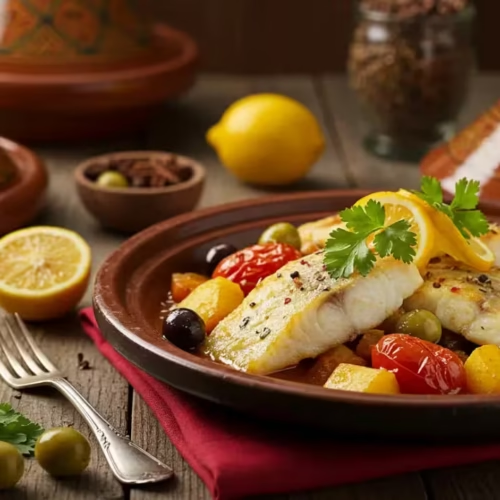
Savory Moroccan Pollock Fish Recipes You’ll Love
Equipment
- Tagine Pot (or Dutch Oven) Traditional tagine pots are ideal for slow cooking and retaining moisture, but a Dutch oven or any heavy-lidded pot works just as well.
- Mixing Bowls For marinating the pollock and preparing spice blends.
- Cutting board and knife To chop vegetables, slice preserved lemons, and prepare ingredients.
- Wooden spoon or spatula For stirring the base ingredients and handling the fish gently to prevent breaking.
- Measuring Spoons and Cups To accurately measure spices, olive oil, and stock.
- Sauté Pan (Optional) If you prefer to sauté the onions and vegetables separately before transferring to the tagine pot.
- Grater or Zester For grating garlic or zesting fresh lemon if you’re not using preserved lemons.
Ingredients
For the Fish Marinade:
- 4 pollock fillets fresh or thawed if frozen
- 2 tbsp olive oil
- 2 tbsp fresh lemon juice
- 3 garlic cloves minced
- 1 tsp ground cumin
- 1 tsp paprika
- 1/2 tsp turmeric
- Salt and pepper to taste
For the Tagine Base:
- 2 tbsp olive oil
- 1 onion thinly sliced
- 2 tomatoes chopped
- 1 cup potatoes sliced into rounds
- 1/2 cup green or black olives
- 2 preserved lemons thinly sliced
- 1/2 cup fish or vegetable stock
- A pinch of saffron threads soaked in 2 tbsp warm water
- Fresh parsley and cilantro chopped (for garnish)
Instructions
Marinate the Fish:
- In a bowl, combine olive oil, lemon juice, garlic, cumin, paprika, turmeric, salt, and pepper.

- Coat the pollock fillets evenly with the marinade and let them rest for 30 minutes in the refrigerator.
Prepare the Tagine Base:
- Heat olive oil in a tagine pot (or Dutch oven) over medium heat.

- Add sliced onions and sauté until soft and fragrant.
- Layer the potato slices over the onions, followed by the chopped tomatoes, olives, and preserved lemon slices.
Assemble the Tagine:
- Place the marinated pollock fillets gently on top of the vegetable mixture.

- Pour the saffron water and fish/vegetable stock evenly over the ingredients.
Cook the Tagine:
- Cover the tagine with its lid and reduce the heat to low.

- Simmer gently for 25-30 minutes, checking occasionally to ensure nothing sticks.
Garnish and Serve:
- Once the fish is cooked through (it should flake easily), garnish with fresh parsley and cilantro.

- Serve the tagine directly from the pot with couscous, flatbread, or steamed vegetables.
Notes
- If you don’t have preserved lemons, substitute with fresh lemon slices and a pinch of salt.
- For added spice, include 1 tsp of harissa paste in the marinade or tagine base.
- This dish tastes even better the next day as the flavors develop—reheat gently to serve.
Nutrition Information (Per Serving)
| Nutrient | Amount |
|---|---|
| Calories | ~350 |
| Protein | 32g |
| Carbohydrates | 15g |
| Fat | 15g |
| Fiber | 4g |
| Sodium | ~600mg |
Clarifying Essential Terms and Ingredients
To help you better understand the ingredients and elements mentioned in this article, here are brief explanations of key terms commonly used in Moroccan cuisine:
Khobz
This traditional Moroccan bread is a round, flat loaf with a dense yet soft texture. Used to scoop up tagines, stews, and dips, khobz is a staple in every Moroccan household. Made with simple ingredients like flour, water, salt, and yeast, it embodies the communal and cultural traditions of Morocco.
Ras el Hanout
A hallmark of Moroccan spice blends, “Ras el Hanout” translates to “head of the shop,” representing the finest spices a merchant can offer. This versatile blend typically includes a mix of warming spices such as cinnamon, cumin, turmeric, and ginger, and is used to flavor iconic dishes like tagines and couscous.
Saffron
Revered as “the golden spice,” saffron is obtained from the fine, hand-harvested threads of the crocus flower, making it a rare and precious addition to any dish. It imparts a rich yellow color and a subtle, earthy aroma to Moroccan dishes, from tagines to desserts. Its labor-intensive harvesting process makes it one of the most valuable spices in the world.
Stay connected and join me on social media
For more delicious recipes, cooking tips, and inspiration! Follow along for updates, behind-the-scenes content, and mouthwatering food ideas. Let’s share the joy of cooking together!
Get notified when we post new tasty recipes!
📩 Join Our Moroccan Foodie Community
Get the best Moroccan tagine recipes and seasonal culinary tips straight to your inbox.
💬 We’d Love to Hear from You!
Tried one of these Moroccan pollock fish recipes at home? Let us know how it turned out!
Did you add your own twist, change up the spices, or pair it with something delicious?
Share your experience in the comments below — we’re excited to hear what you think, and your tips might inspire other food lovers too!
